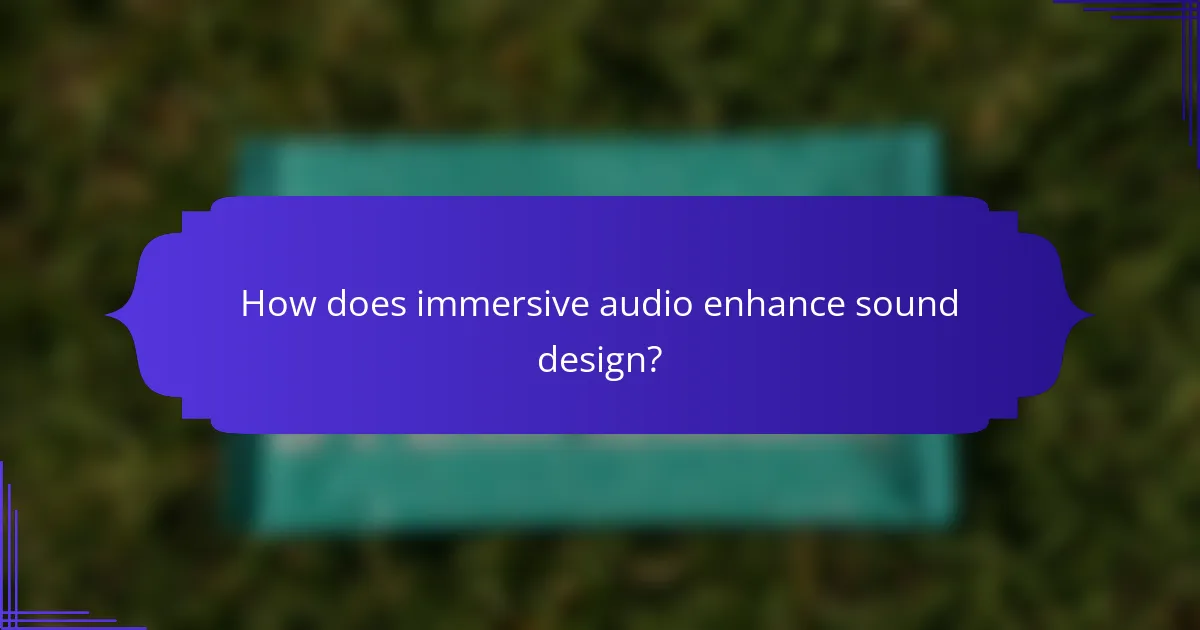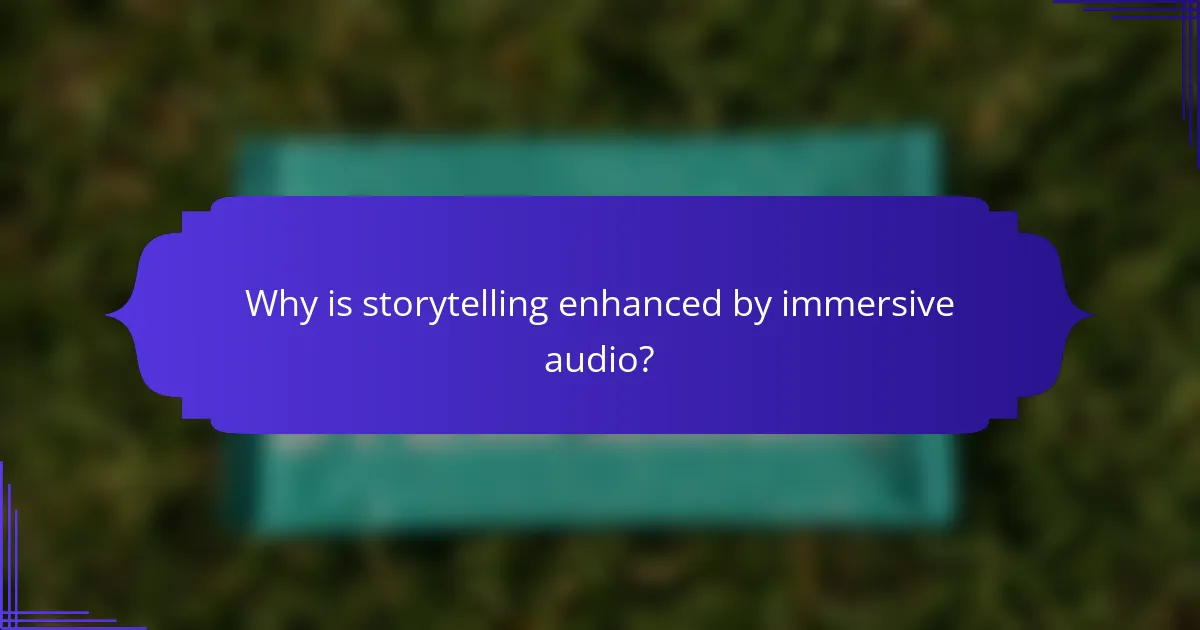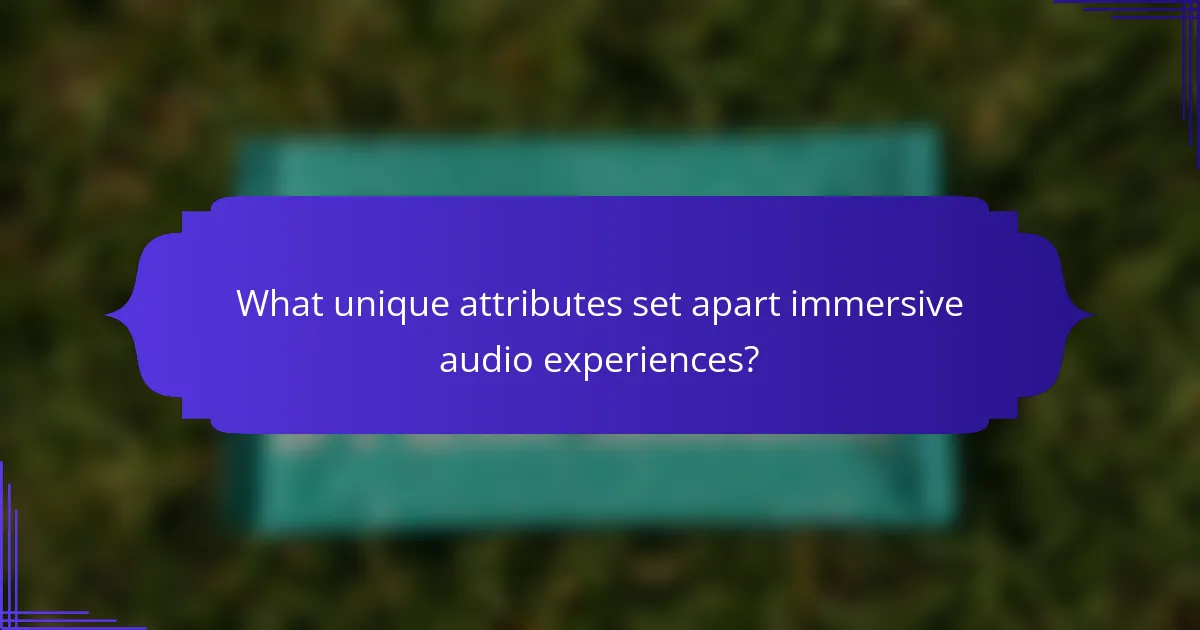Immersive audio significantly enhances player experience by creating a realistic and engaging environment. It improves sound design through spatial audio effects, enriching storytelling with dynamic soundscapes. This technology deepens emotional connections and allows for real-time interactivity, transforming gameplay into a more personalised adventure. Key techniques include implementing spatial audio and incorporating player feedback mechanisms to optimise the auditory experience.

How does immersive audio enhance sound design?
Immersive audio enhances sound design by creating a multidimensional auditory experience that engages listeners. This technology allows for spatial audio effects, making sounds appear to come from various directions, which deepens emotional connections to narratives. For example, in gaming, immersive audio can simulate environmental sounds, heightening realism and player immersion. Additionally, it enables sound designers to craft unique audio landscapes, enriching storytelling and elevating overall player experience.
What are the core principles of sound design in immersive audio?
The core principles of sound design in immersive audio include spatialization, dynamic range, and environmental acoustics. Spatialization creates a sense of directionality and distance, enhancing realism. Dynamic range ensures sounds vary in intensity, contributing to emotional impact. Environmental acoustics simulate real-world sound behaviour, enriching the listener’s experience. These principles collectively elevate storytelling and player engagement in immersive environments.
Which technologies are pivotal for immersive sound design?
Spatial audio, binaural sound, and advanced mixing techniques are pivotal for immersive sound design. These technologies enhance storytelling and player experience by creating a realistic and engaging auditory environment. Spatial audio allows sounds to move around the listener, providing depth and directionality. Binaural sound captures audio as humans hear it, simulating a 3D soundstage. Advanced mixing techniques ensure that sound elements blend seamlessly, enhancing the overall narrative and emotional impact. Together, these technologies elevate the immersive quality of audio in various media.
How do spatial audio techniques influence sound design?
Spatial audio techniques significantly enhance sound design by creating immersive environments that engage players. These techniques allow for realistic sound placement, making audio cues more impactful. For example, sounds can shift dynamically based on player movement, enhancing storytelling. This results in a more engaging player experience, as audio becomes a crucial element in narrative delivery. By leveraging spatial audio, designers can create an emotional connection, deepening player immersion and interaction within the game world.
What role does sound layering play in creating immersive experiences?
Sound layering significantly enhances immersive experiences by creating depth and realism in audio environments. This technique allows for the simultaneous use of multiple sound elements, such as ambient sounds, dialogue, and music, to evoke emotions and support storytelling. By strategically layering sounds, designers can guide player attention and enhance engagement. Unique attributes, such as spatial audio, further enrich the experience by providing a sense of directionality, making the environment feel more alive. As a result, sound layering becomes a vital tool in crafting compelling narratives and enhancing overall player immersion.

Why is storytelling enhanced by immersive audio?
Immersive audio enhances storytelling by creating a more engaging and realistic experience. It deepens emotional connections by using soundscapes that reflect the narrative. This audio design allows for spatial awareness, making listeners feel present in the story. As a result, immersive audio transforms passive listening into active participation, enhancing overall player experience.
How does immersive audio affect narrative engagement?
Immersive audio significantly enhances narrative engagement by creating a more realistic and emotionally resonant experience. It draws listeners into the story, amplifying their connection to characters and plot. This sound design technique utilises spatial audio and dynamic soundscapes to immerse players in the narrative. As a result, players feel more present in the story world, which increases their emotional investment and overall enjoyment. Studies show that immersive audio can improve retention of story details and enhance user satisfaction, making it a crucial element in modern storytelling.
What are the psychological impacts of sound on storytelling?
Sound profoundly affects storytelling by enhancing emotional engagement and immersion. It shapes audience perception, guiding their emotional responses and creating a more vivid narrative experience.
Psychological studies indicate that specific soundscapes can evoke distinct emotions. For example, high-pitched tones may induce tension, while harmonious melodies can promote relaxation. This manipulation of sound creates a unique attribute of immersive audio, enabling storytellers to craft experiences that resonate deeply with audiences.
Furthermore, sound design influences memory retention. Research shows that narratives accompanied by sound are remembered more vividly than those without. This phenomenon highlights the root attribute of sound’s role in enhancing storytelling effectiveness.
In interactive media, player experience is significantly enriched through sound cues. These auditory signals provide feedback, enhancing the sense of agency and presence. As a result, players feel more connected to the narrative, showcasing the rare attribute of sound’s ability to bridge the gap between player and story.
Which case studies demonstrate successful storytelling through immersive audio?
Case studies showcasing successful storytelling through immersive audio include “The Invisible Hours,” which uses spatial audio to enhance narrative depth, and “The Night Cafe,” which employs soundscapes to create an engaging environment. “The Walking Dead: Our World” integrates audio cues to enrich player experience, while “The Ghosts of the West” utilises binaural sound for immersive storytelling. These examples highlight how immersive audio elevates emotional engagement and narrative complexity.

How does player experience change with immersive audio?
Immersive audio significantly enhances player experience by creating a more engaging and realistic environment. This sound design technique allows players to feel as if they are part of the game world. Enhanced spatial awareness leads to improved gameplay, as players can better locate in-game sounds, such as footsteps or environmental cues.
The storytelling aspect is also elevated, making narratives more compelling. For instance, dynamic audio can reflect character emotions or plot developments, deepening emotional connections. Additionally, immersive audio can adapt to player actions, further personalising the experience.
Overall, the integration of immersive audio transforms gameplay, making it more interactive and emotionally resonant.
What are the benefits of immersive audio for player immersion?
Immersive audio significantly enhances player immersion by creating a realistic sound environment. It deepens emotional engagement, facilitates storytelling, and improves situational awareness. Players experience heightened presence through spatial audio cues, which mimic real-world acoustics. This leads to a more compelling and memorable gaming experience.
How do different gaming platforms implement immersive audio?
Different gaming platforms implement immersive audio through advanced sound design techniques, enhancing storytelling and player experience. Platforms like VR systems utilise 3D audio to create spatial awareness, while consoles and PCs leverage high-fidelity sound systems for realistic environments. Mobile games often use adaptive audio that responds to player actions, maintaining engagement. Unique attributes like adaptive soundscapes and interactive music scores deepen immersion, making players feel more connected to the game world. Rare implementations, such as binaural audio for headphone users, provide a distinct auditory experience, further enriching gameplay.
What challenges do developers face in creating immersive audio experiences?
Developers face several challenges in creating immersive audio experiences. Balancing sound quality with performance constraints is a primary issue. Additionally, integrating audio seamlessly with visual elements can be complex. Ensuring accessibility for diverse users adds another layer of difficulty. Finally, keeping up with evolving technologies and tools requires continuous learning and adaptation.

What unique attributes set apart immersive audio experiences?
Immersive audio experiences stand out due to their unique attributes like spatial audio, real-time interactivity, and emotional resonance. Spatial audio creates a 360-degree sound environment, enhancing realism. Real-time interactivity allows users to influence soundscapes, deepening engagement. Emotional resonance connects sound design with storytelling, fostering a memorable player experience. These elements collectively elevate immersion, setting immersive audio apart from traditional sound design.
How do cultural factors influence immersive audio design?
Cultural factors significantly shape immersive audio design by influencing sound aesthetics and storytelling techniques. Different cultures prioritise unique sounds, rhythms, and narratives, impacting how audio experiences are crafted. For instance, traditional music elements can enhance emotional resonance, while language variations affect voice acting and dialogue delivery. Moreover, cultural context determines the expectations of audio realism and abstraction, guiding designers in creating tailored experiences. Understanding these cultural nuances allows developers to engage diverse audiences more effectively, enriching player experience through culturally relevant audio landscapes.
What rare techniques are used in high-end immersive audio productions?
High-end immersive audio productions employ rare techniques such as ambisonics, binaural recording, and spatial audio rendering. These methods enhance sound design and storytelling, creating a richer player experience.
Ambisonics captures sound from all directions, allowing for a three-dimensional audio field. Binaural recording uses two microphones to replicate how human ears perceive sound, enhancing realism. Spatial audio rendering manipulates sound placement in a virtual space, providing an immersive listening experience.
These techniques are not commonly used in standard audio production, making them unique attributes that distinguish high-end immersive audio from conventional formats.

Which best practices can optimize immersive audio integration?
To optimize immersive audio integration, focus on spatial audio techniques, dynamic soundscapes, and player feedback mechanisms. These practices enhance realism and engagement, creating a more compelling experience.
1. Implement spatial audio to create a three-dimensional sound environment.
2. Use dynamic soundscapes that adapt to player actions and in-game events.
3. Incorporate player feedback mechanisms to adjust audio based on user preferences.
4. Test audio in various environments to ensure consistency and quality.
5. Collaborate with sound designers and storytellers to align audio with narrative elements.
6. Continuously update audio assets based on player interactions and feedback.
What common mistakes should developers avoid in immersive audio design?
Developers should avoid common mistakes like neglecting spatial audio cues, overusing sound effects, ignoring player feedback, and failing to optimise audio for performance. These errors can diminish storytelling and player immersion.
Neglecting spatial audio cues reduces the sense of presence. Developers must ensure sound placement corresponds accurately to visual elements. Overusing sound effects can lead to audio clutter, distracting players from key narrative elements.
Ignoring player feedback limits the opportunity for improvement. Engaging with users can reveal valuable insights into audio effectiveness. Failing to optimise audio can lead to performance issues, affecting overall player experience. Prioritising audio quality while maintaining performance is essential for immersive design.
How can feedback loops enhance immersive audio experiences?
Feedback loops significantly enhance immersive audio experiences by creating dynamic soundscapes that respond to player interactions. This adaptability fosters deeper engagement and emotional connection to the narrative. For instance, if a player approaches a character, the audio can shift to reflect proximity, enhancing realism. Real-time adjustments based on player actions can lead to unique auditory experiences, making each session distinct. Such responsive audio design supports storytelling by reinforcing themes and moods, ensuring players remain immersed throughout their journey.
What expert tips can improve immersive audio implementation?
To improve immersive audio implementation, focus on spatial audio techniques, dynamic soundscapes, and player feedback integration. Prioritise 3D audio positioning to enhance realism. Utilise adaptive audio that responds to player actions for deeper engagement. Implement sound layering to create a rich auditory environment. Regularly test audio in context to ensure it complements the narrative and gameplay.
